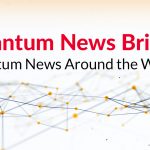Hybrid systems are the future of quantum computing and they’re here now

Ask any technologist when a true quantum computer will be ready for prime time and you’ll get an answer ranging anywhere from five to 10 years, even longer. But the future of quantum computing may very likely be found in hybrid systems—systems available today—that allow developers and engineers to integrate classical silicon and quantum workflows.
For example, D-Wave Systems, a Canadian company, has steadily improved its quantum-classical architecture, known as quantum annealing, over the last decade to address real optimization and modeling problems for clients around the world.
D-Wave’s hybrid offering is being used by Mastercard to optimize their customers’ loyalty programs, by global professional services company Deloitte to reduce the time to produce schedules for airport security personnel from a month to minutes, at the Port of Los Angeles to improve crane operations and truck turn times, in Japan to optimize the delivery of TV advertising, and by Pattison Food Group to optimize the schedules for their ecommerce drivers.
“What we’ve found is that classical computing and quantum computing have complementary strengths when it comes to producing solutions for business applications,” D-Wave Systems Vice President of Product Management Murray Thom said in an interview.
“You can always put them together in a way where they can do a better job of solving larger problems,” he maintained.
Microsoft, too, is in the hybrid game. It’s integrating quantum services into its Azure cloud and providing users with software that will enable them to write code that will run on those services.
“We’re architecting our machine so that the best performance can be obtained across both the classical and quantum parts,” Krysta Svore, an engineer and vice president of Advanced Quantum Development at Microsoft, said in an interview.
“It also requires architecting a hybrid system—not only are the algorithms a mixture of quantum and classical code, but keeping the machine fault tolerant also requires advanced classical computing,” she explained. “This means that we need to have a supercomputer at the helm, with the quantum computer as the engine.”
Meanwhile, IBM is working on a path to quantum-centric supercomputing, which includes interaction with classical computers through a hybrid cloud.
Intel is contributing to the hybrid scene, too. Its Horse Ridge chip allows the interface to be simplified between the control and measurement layer and the control processor layer of the hybrid system. Horse Ridge acts as a cryogenic control chip, allowing the classical electronics in the control processor layer to function in the extremely low temperatures needed for the control and measurement layer to function.
“Quantum-classical hybrid systems are here to stay,” Daniel Justice, a software developer in the AI division of the Software Engineering Institute at Carnegie Mellon University, said in an interview.
“A purely quantum system is not desirable because quantum computers are not better than classical computers for every task,” he continued. “It is much more efficient to use classical computers for simple tasks and quantum computers only when necessary.”
He noted that another advantage of hybrid systems is that they can be more fault tolerant. “The classical computer can be used to detect and correct errors that may occur in the quantum computer,” he explained. “This can help to increase the reliability and robustness of the system.”
“Overall, hybrid computing is a practical and necessary approach to quantum computing, and it will continue to be used as we move towards large-scale, fully capable quantum computers,” he added.
Svore agreed that the future of quantum computing is hybrid computing. “While an incredible technology, quantum computers rely on classical supercomputers to interpret and relay quantum data into a readable format,” she said.
“A standalone quantum system cannot operate without classical compute preparing what has to be computed, analyzing the results and deciding what further computation needs to be performed,” she continued.
“Quantum computing is hybrid by nature,” she added. “It is today with the current generation of quantum computers made of noisy qubits, and it will be in the future with fault-tolerant quantum computers made of millions of reliable and fast qubits.”
While some analysts persist in using the term hybrid to suggest that the classical-quantum interface will be only a temporary phase or “bridge” to full-scale quantum computing, companies are increasingly realizing that hybrid systems will be an integral part of the quantum future, as well as the present, Arthur Herman, senior fellow and director of the Quantum Alliance Initiative, wrote for the Hudson Institute.
“Building and designing the systems that facilitate the interface between quantum and conventional elements, then, are not simply temporary fixes,” he added. “They are foundational to the future of quantum technology adoption.”
“While even major players in the industry, like Microsoft, IBM, and Dell, recognize this reality,” he continued, “policymakers need to recognize it as well and guide our national quantum policy accordingly.”























